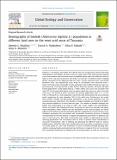| dc.description.abstract | Baobab is a deciduous non-timber tree species that are facing severe threats from both anthropogenic and climatic pressures across its range states. This study assessed natural rates of recruitment and associated threats of baobabs within and across different land-use types in semi-arid areas of Tanzania. The study was based on a stratified random sampling design composed of the following land-use types: strictly protected areas, non-strictly protected areas, and unprotected areas. Rates of recruitment were measured from a total of 337 grids (representing 40% of semi-arid land) in three different land-use types in a plot measuring 1 km long and 50 m wide. Results show that juvenile, sub-adult and adult baobab populations varied significantly (p < 0.001) within and across land-use types with only 4.7% of surveyed plots having a few juveniles (about four stems per plot) across the study area. The density of adult, sub-adult and juvenile populations were 1.53 ± 0.105, 0.82 ± 0.149 and 0.33 ± 0.253 plants/ha respectively with strictly protected areas (national parks) supporting the most abundant (53%) of the adult trees. Furthermore, the results show inverse J-shaped and bell-shaped distribution in the strictly protected areas and unprotected areas, respectively. The densities of mature baobabs were found to be higher than juvenile baobabs in all three land-use types. The number of baobabs damaged was higher than undamaged in all land-use types. Our results suggest that anthropogenic threats are higher than biophysical factors in driving the species to mortality and population extirpation. Likely, baobab size and distribution across land-use types are mostly influenced by herbivory and fire that likely limit the establishment in most of these areas. Strategies promoting the recruitment and sustainable harvesting practices of baobab would perhaps be the best options to support the population persistence in different land uses in semi-arid areas. The study recommends more studies to understand the factors affecting germination and recruitment rates in order to predict future distributions in semi-arid environments. Also in defining and planning for different land-use system, baobab species should be taken into consideration and in particular in agroforestry farms can easily qualify as a tree crop. Promotion of active recruitment through planting especially in communal lands and protection from herbivory is required if we are to overcome the recruitment bottlenecks as influenced by increasing impacts of land use and climate change and overexploitation. The intentional growing of trees and shrubs in combination with crops cultivation and forage production is also recommended to smallholder farmers. | en_US |

